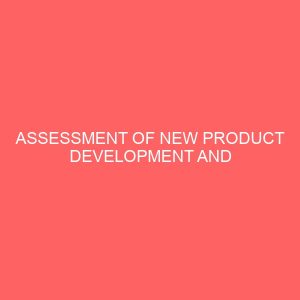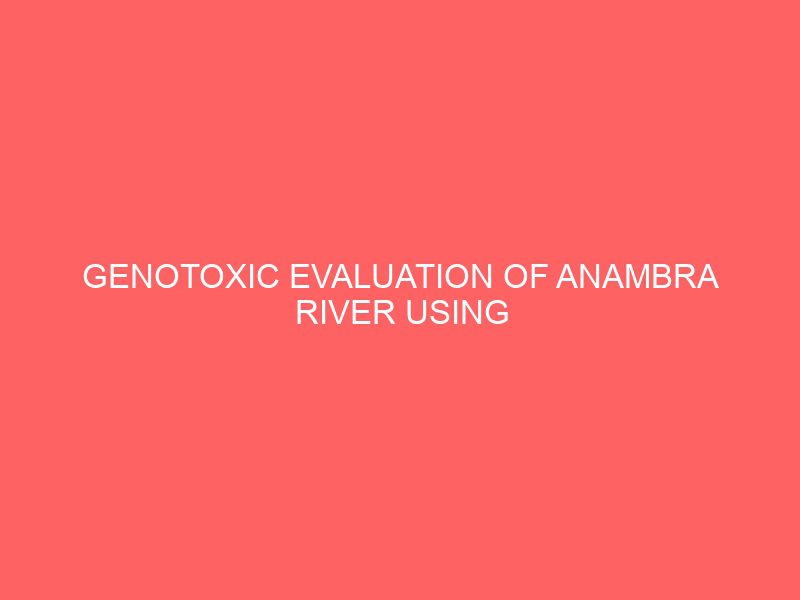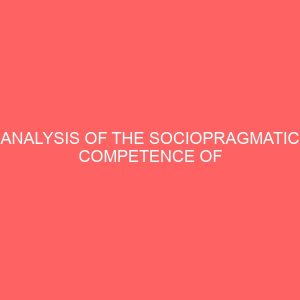Description
ABSTRACT
Genotoxicity of freshwater fish in Anambra River was studied by micronucleus MN assay, and the resultant micronucleus indices were used as biomarkers to estimate and predict pollution profile and possible danger of feeding on the aquatic species. The micronucleus profiles of the fish were measured from gill and kidney erythrocytes using microscopic technique. Season, breed, and location effects on micronucleus indices, together with their interactions, and the correlation between the pollutants in fish, water ecosystem, and the micronucleus profiles were also studied. Two major seasons Rainy and Dry and preponderant fish breeds in the river Synodontis clarias Linnaeus, 1758 and Tilapia nilotica Linnaeus, 1757 were studied at five distinct locations that displayed differential environmental stresses. The study revealed that the micronucleus index of fish is an excellent biomarker for measuring the level of pollution in a freshwater habitat. This is more evident with regard to zinc and copper. Season, breed and location affect micronucleus profile adversely and strong correlations exist between zinc and copper in water and fish and micronuclei profiles. Disease outbreak among rural dwellers depending on the water for domestic and other uses is imminent and they lack knowledge on its health implication. Furthermore, the study maintained that the micronucleus in fish could be measured with higher efficiency from the gill than the kidney erythrocytes and Synodontis clarias is more vulnerable to genetic damage due to high zinc and copper pollutants than Tilapia nilotica. Consequently, the study recommends environmental sensitization of the resident population and regular monitoring micronucleus tests of edible aquatic life such as Synodontis clarias catfish in order to eliminate the danger of people feeding on toxic metals, some of which are carcinogenic.
CHAPTER ONE
INTRODUCTION
1.1 Background
Many toxic and potentially toxic chemical substances, some of which are of natural origin and others due to human activities are available in the fresh water ecosystem daily. It is difficult to practise even elementary hygiene without sufficient quantities of water free of these contaminants UNFPA, 2001. As such, it is necessary to protect the water sources themselves from faecal, agricultural, and industrial contaminations pollutants. In developing countries, 90 to 95 percent of all sewage and 70 percent of all industrial wastes are dumped untreated into surface water UNFPA, 2001. Due to the increasing environmental exposure to these agents, the need for monitoring terrestrial and aquatic ecosystems, especially in regions compromised by chemical pollution is paramount Mitchelmore and Chipman, 1998; Avishai, Rabinwitz, Moiseeva and Rinkevch, 2002; Silva, Heuser and Andrade, 2003; Matsumoto, Janaina, Mario, Maria, 2005.
Genotoxic pollution of aquatic ecosystem describes the introduction of contaminants with mutagenic, tertogenic and/or carcinogenic potentials into its principal media and genome of the resident organisms Badr and ElDib, 1978; Environ Health Perspect, 1996; Fagr, El Shehawi and Seehy, 2008. Genotoxicity is a deleterious action, which affects a cells genetic material affecting its integrity Environ Health Perspect, 1996; WHO, 1997. Several genotoxic substances are known to be mutagenic and carcinogenic, specifically those capable of causing genetic mutation and of contributing to the development of human tumors or cancers Black, Birge, Westerman and Francis, 1983; Hose, Hannah, Puffer and Landolt, 1984; Hose, 1985; Baumann and Mac, 1988; Shugart, 1988; Hayashi,
TABLE OF CONTENT
CERTIFICATION i
DEDICATION ii
ACKNOLWEDGEMENT iii
ABSTRACT v
CHAPTER ONE: INTRODUCTION 1
1.1 Background 1
1.2 Statement of the Problem 7
1.3 Research Questions 10
1.4 Research Aim and Objectives 10
1.5 Research Hypothesis 11
1.6 Justification of Study 12
1.7 Significance of Study 14
1.8 Scope of Study 15
1.9 Limitations of Study 16
1.10 Conceptual Framework 18
1.11 Description of the Study Area 25
1.11.1 Location and Extent of Anambra River 25
1.11.2 Geology 25
1.11.3 Climate 27
1.11.4 Hydrology 28
1.11.5 Landuse and Landcover 29
1.11.6 Sources of Freshwater, Pollutants, and their Distribution 30
1.12 Plan of Study 35
CHAPTER TWO: LITERATURE REVIEW 36
2.1 Aquatic Pollution Biomarkers 36
2.2 Heavy Metals 42
2.2.1 Types and Sources of Heavy Metals in Freshwater Ecosystems 44
2.2.2 Distribution Channels of Heavy Metals in Anambra River 48
2.2.3 Single and Joint Action Toxicity and Genotoxicity of Heavy Metals and Micronucleus Formation 49
2.2.4 Bioindicators and Bioaccumulation of Aquatic Heavy Metals and other Sublethal Effect of Heavy Metals 57
2.2.5 Public Health Implications of Heavy Metal Pollution of Freshwater 62
2.3 Polycyclic Aromatic Hydrocarbons as an Environmental Organic Pollutant 66
2.3.1 Entry into the Environment 67
2.3.2 Effects Related Information 69
2.3.2.1 Experimental Animals and In Vitro 69
2.3.2.2 Humans 70
2.3.2.3 Ecotoxicology 70
CHAPTER THREE: METHODOLOGY 76
3.1 Research Design 76
3.2 Data Needs 80
3.3 Data Sources 80
3.4 Experimental Site 81
3.5 Sample Collection and Analysis 81
3.5.1 Collection of Fish and Water Samples 84
3.5.2 Laboratory Analysis 84
3.5.2.1 Biomarker Assay: Micronucleus Test 84
3.5.2.2 Physicochemical Parameters 85
3.5.2.3 Heavy Metal Analysis of Water and Fish Samples 86
3.5.2.4 Polycyclic Aromatic Hydrocarbon Analysis 86
3.5.2.5 EcoGenotoxicology: Micronucleus Inducing Activity of Heavy Metals Acting Singly and Jointly in Mixture against Test animals 88
3.6 Public Survey 90
3.7 Statistical Analysis 91
CHAPTER FOUR: DATA PRESENTATION ANALYSIS AND
DISCUSSION 93
4.1 Data Presentation 93
4.1.1 Season, Breed, and Location Effects on Incidence of Micronucleus MN 93
4.1.1.1 Season x Breed, Season x Location and Breed x Location Interaction Effects 94
4.1.1.2 Season x Breed x Location Interaction Effects 96
4.1.2 Physicochemical Parameters 103
4.1.3 Heavy Metal Concentrations 105
4.1.3.1 Seasons, Breed and Location Effects on the Heavy Metal Concentrations 105
4.1.3.2 Season x Breed, Seasons x Location, and Breed x Location Interaction Effects 106
4.1.3.3 Seasons x Breed x Location Interaction Effects 108
4.1.3.4 Season and Location Effects on Heavy Metal Concentrations in Water Column 109
4.1.3.5 Season x Location Interaction Effects 110
4.1.4 Polycyclic Aromatic Hydrocarbon Concentrations in Anambra River 111
4.1.5 Correlation between Heavy Metal Concentrations in Water and Fish and Micronuclei Profile 111
4.1.6 Single and Joint Action Genotoxicity Studies of Copper and Zinc against Synodontis clarias and Tilapia nilotica 112
4.1.7 Public Survey 114
4.2 Data Analysis 116
4.3 Discussion of Findings 119
4.3.1 Breed Effect 119
4.3.2 Season Effect 120
4.3.3 Location Effect 121
4.3.4 Relationship between Heavy Metals in Principal Media and Micronuclei Formation 122
4.3.5 Distribution of Physicochemical Parameters and Heavy Metal Genotoxic Effects 123
4.3.6 Responses from the Residents 128
CHAPTER FIVE: SUMMARY CONCLUSIONS AND
RECOMMENDATIONS 132
5.1 Summary 132
5.2 Conclusions 133
5.3 Recommendations 135
5.3.1 Recommendations for Further Studies 137
REFERENCES 139
LIST OF TABLES
Table 1.1 Diversity of fish fauna in the Anambra River 29
Table 2.1 Mean values of Micronucleated Erythrocytes Examined in Blood and Kidneys of Fish Caught from Different Locations 39
Table 2.2 Heavy Metal Concentrations g/g in Synodontis clarias 43
Table 2.3 Genotoxicity of Copper In Vivo 52
Table 2.4 Genotoxicity of Copper In Vitro 53
Table 2.5 Genotoxicity of Zinc In Vivo 54
Table 2.6 Most Sensitive Toxicity Endpoints Reported for Polycyclic Aromatic Hydrocarbons for Freshwater Organisms 72
Table 3.1 Instrument for In situ Measurements 82 Table 4.1 Season, Breed and Location Effects on the Mean S.E Incidence of Micronucleus in Gill and Kidney blood of Freshwater Fish 93
Table 4.2 Season x Breed, Seasons x Location and Breed x Location Interaction Effects on Mean S.E Incidence of Micronucleus in Gill and Kidney blood of Freshwater Fish 95
Table 4.3 Season x Breed x Location Interaction Effects on the Mean S.E Incidences of Micronucleus in Gill and Kidney blood of Freshwater Fish 96
Table 4.4 Relative Abundance of Micronuclei MN in Kidney and Gill at Different Locations of Anambra River during Rainy Season 100
Table 4.5 Relative Abundance of Micronuclei MN in Kidney and Gill at Different Locations of Anambra River during Dry Season 100
Table 4.6 Physicochemical Characteristics of Anambra River in Mid Rainy Season July, 2009 104








Reviews
There are no reviews yet.